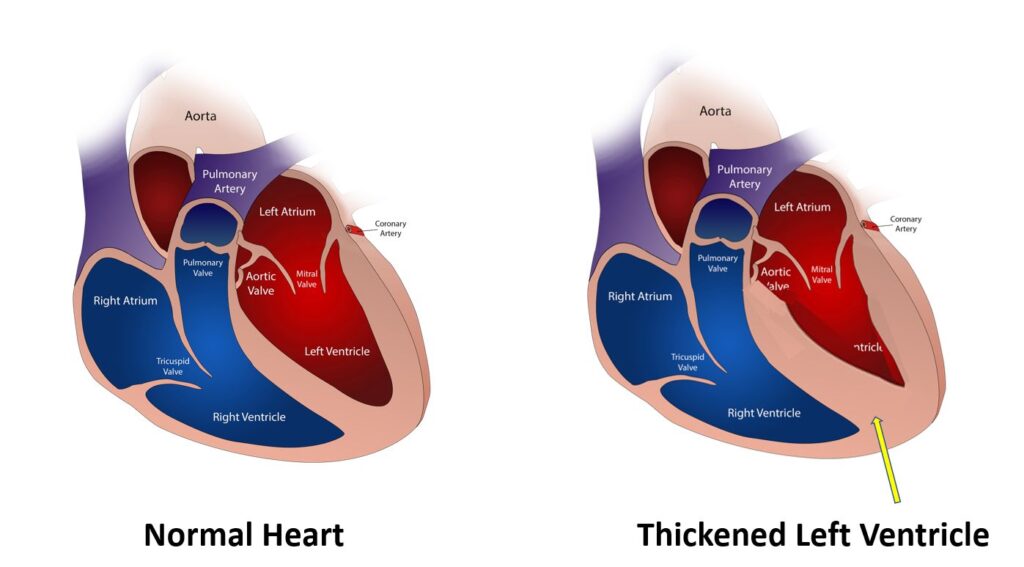What is hypertrophic cardiomyopathy?
What is hypertrophic cardiomyopathy?
Hypertrophic cardiomyopathy is a disease of the heart muscle in which the muscle becomes unduly thickened. It is a heritable disorder in which half of the first degree relatives may be affected. The disease can be passed on from parents to children.

There are two varieties, one with obstruction to the flow of blood from the left ventricle to aorta and another without obstruction. Left ventricle is the lower left chamber of the heart which pumps blood to the aorta. Aorta is the largest blood vessel arising from the left ventricle, taking oxygenated blood to the whole body.
The obstructive variety is known as hypertrophic obstructive cardiomyopathy or HOCM in short. The non-obstructive variety is known as hypertrophic non-obstructive cardiomyopathy or HNOCM. In the obstructive variety, as the blood flow is partly obstructed, more symptoms are likely. Shortness of breath on exertion can occur in both varieties.
In the obstructive variety, fainting is an additional important symptom. Fainting usually occurs soon after exertion, due to the obstruction of blood flow from the left ventricle. Reduced blood flow to the brain causes sudden loss of consciousness and a fall, known as syncope. Abnormally fast heart rhythms which can occur in hypertrophic cardiomyopathy can also be a cause for syncope.
In both obstructive and non-obstructive varieties, the thickened heart muscle is stiff and unable to relax properly. Hence the heart is unable to receive blood fully when it relaxes after a heart beat. This causes a decrease in the amount of blood which can be pumped out when the heart beats.
Important symptoms of hypertrophic cardiomyopathy are chest pain, mostly on exertion, shortness of breath, fatigue, giddiness, and abnormal heart rhythms known as arrhythmias, causing palpitation. In the late stages when the heart fails, swelling of the ankles, legs and tummy may occur due to fluid collection. Many persons with hypertrophic cardiomyopathy may be asymptomatic. These persons are identified either during a family screening or on routine medical check up for other reasons.
Hypertrophic cardiomyopathy can worsen over time and lifestyle changes are needed. There is also a potential risk for sudden death, mostly due to abnormal heart rhythms. Hypertrophic cardiomyopathy is the most common cause for sudden death in athletes and young persons below the age of 35 years.
Atrial fibrillation, a fast irregular rhythm originating from the upper chambers of the heart places the person at risk for clot formation in the heart and consequent stroke. In this case the clot moves out from the heart and blocks blood vessels of the brain to produce sudden weakness of a part of the body or stroke.
Hypertrophic cardiomyopathy may be present in one of every 500 individuals, but mostly undiagnosed. Important test which helps in the diagnosis of hypertrophic cardiomyopathy is an echocardiogram or ultrasound study of the heart. Other useful tests are ECG, cardiac MRI, ambulatory ECG monitoring (Holter) and genetic testing.

Medications which reduce the contractile force of the heart offer limited relief of symptoms of hypertrophic cardiomyopathy. Lifestyle modifications include avoiding competitive sports and undue exertion. But each person has to follow the advice from the treating physician as there is a wide range in the severity of the disorder.
If there is no relief with medical treatment removal of the excessive thickness of the heart muscle by an operation known as septal myectomy is an option. But this is generally for younger people with obstructive variety and severe symptoms.
Injection of alcohol into a small branch of the blood vessel supplying the thickest portion of the heart muscle is a non-surgical procedure done under X-ray fluoroscopic imaging. This procedure is called alcohol septal ablation. It is done in cardiac catheterization laboratory. Muscle cells damaged by the injection of alcohol shrinks and the abnormal thickness decreases. This procedure is considered mainly for older persons who have higher risk for open heart surgery.
An important device which is used in the treatment of hypertrophic cardiomyopathy is an implantable cardioverter defibrillator known in short as an ICD. This device is implanted when there are life threatening abnormalities of heart rhythm. ICD monitors the heart rhythm continuously and can treat abnormal rhythms by delivering either a controlled electrical shock or timed electrical pulses to the heart.



